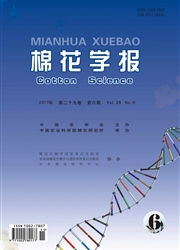

 中文摘要:
中文摘要:
为探讨棉花种子活力的品种差异及不同种子活力测定方法对棉子活力结果的影响,以17个棉花主栽品种(系)为材料,用简化的标准发芽、低温发芽和人工老化发芽3种方法测定棉花种子活力,并分析种子物理性状与种子活力的相关性。结果表明:3种活力测定方法下不同品种间种子活力均存在较大差异,各活力指标表现趋势也不一致,低温条件主要抑制种子幼苗的生长势,老化条件则主要抑制种子的发芽率。简化的标准发芽的活力指数与2种逆境发芽下的活力指数间的相关性较低。对3种测定方法的种子活力指标进行聚类分析,筛选出中棉所102、新陆中42、湘杂7号、XG39K5、屯杂6号及皖杂9号等高活力品种。低温和人工老化发芽条件显著降低了种子活力与种子各物理性状间的相关性。种子密度和健子率在不同发芽条件下均与种子活力关系最密切,可作为判断棉花种子活力大小的物理指标。
 英文摘要:
英文摘要:
To investigate cultivar differences in cotton seed vigor and the effects of different vigor determination methods on cotton seed vigor, we selected 17 cotton cultivars in which to measure seed vigor characteristics. We used simplified standard,low-temperature, and artificial aging germination test conditions, and analyzed the correlation between seed vigor and physical characteristics. Results showed many differences in seed vigor in the different cultivars, and that seed vigor characteristics were not consistent under the three germination test conditions. Seedling growth rate was mainly inhibited under low-temperature conditions, and seed germination percentage was mainly inhibited under artificial aging conditions. The correlation of the vigor index between simplified standard and stress germination was lower. High vigor cultivars CCRI 102, Xinluzhong 42, Xiangza 7,XG39K5, Tunza 6, and Wanza 9 were selected by cluster analysis of the three germination tests. In addition, the correlation between seed vigor and physical characteristics decreased significantly under stress conditions. Because healthy seed percentage and seed density were closely related to cotton seed vigor under different germination conditions, we also conclude that physical characteristics of the seeds can determine the level of seed vigor.
 同期刊论文项目
同期刊论文项目
 同项目期刊论文
同项目期刊论文
 期刊信息
期刊信息
